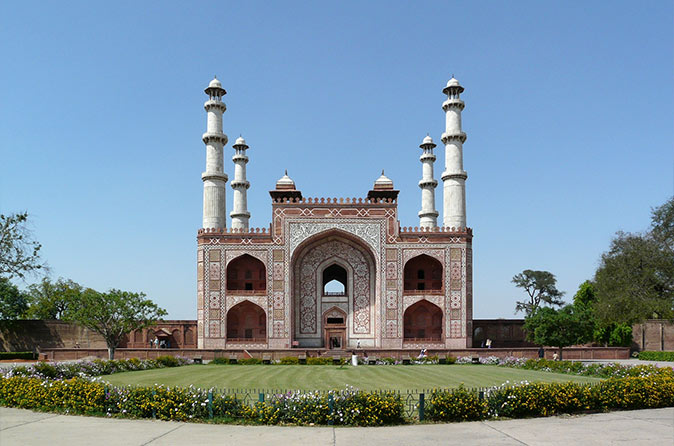Taj Mahal
The Taj Mahal is one of the world’s most recognisable and evocative sights and a visit here does not disappoint. Set overlooking the River Yamuna, visible from Agra Fort in the West, the Taj was built by Shah Jahan to enshrine the body of his favourite wife who died giving birth to her 14th child, in 1631. This story of this great monument to love is given an added poignancy by the fate of Shah Jahan himself. When his devout and austere son Aurangzeb seized power, Shah Jahan was interned in Agra Fort where he lived out his final years gazing wistfully at the Taj Mahal in the distance.When he died there in January 1666, with his daughter Jahanara Begum at his side, his body was carried across the river to lie alongside his beloved wife in his peerless tomb. Completed in 1653, the Taj Mahal is set in a large walled garden, between two mini-Tajs (one of which is a mosque), in front of a long reflective pond. Close up the craftsmanship is as spectacular as at a distance; the inside of the vast double-dome is inlaid with verses from the Koran and semi-precious stones. Visitors should aim to visit it at dawn and dusk when the reflection of the sun changes the colour of the dome from white to shades of pink. Note that there can often be smog and fog in the mornings.
Telephone: (0562) 233 0498
Opening time: Tuesday to Sunday dawn to dusk (about 6am to 7.30pm)
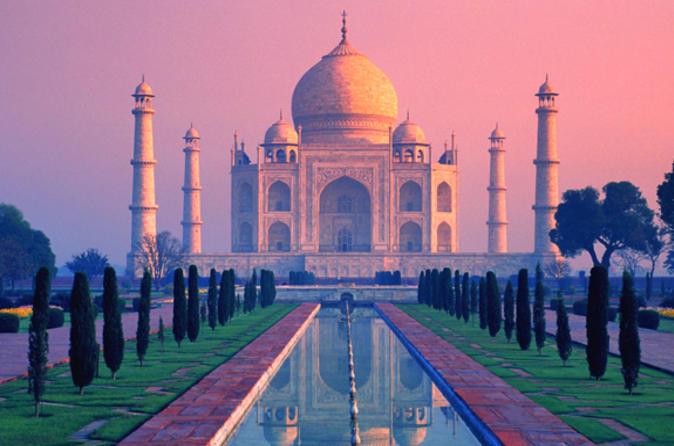
Fatehpur Sikri
The deserted city Fatehpur Sikri was the capital of the Mughal Empire between 1570 and 1585. It was built under the personal supervision of the Emperor Akbar; he was childless and, having tried all sorts of solutions to his plight, visited a Sufi saint, Sheikh Salim Chishti, for help. Soon a son was born and, impressed and overjoyed, he started building on the site where he had met the saint. However due to a severe shortage of water the city was abandoned after only fifteen years and the capital was relocated back to Agra. As a result Fatehpur Sikri stands untouched and perfectly preserved; a complete medieval fortress of red sandstone, with vast central squares, exquisitely carved multi-tiered pavilions, cool terraces and formal gardens. Fatehpur Sikri is a 25 mile (40km) journey west of Agra, on the way to Jaipur.
Transport: There are 3 daily trains that connect Agra Fort and Fatehpur Sikri, and vice versa. The first train leaves Agra Fort at 8.10am, the next at 2pm and the last at 7pm. The journey takes an hour. Refer to www.indianrail.gov.in
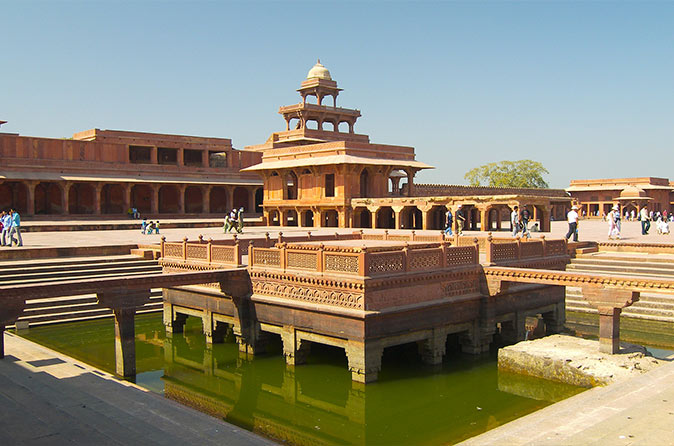
Dayal Bagh
Dayal Bagh is also known as the “garden of the Supreme Lord”, the Dayal Bagh Gardens is located 15 km from Agra and is an important pilgrimage site. The Dayalbagh Gardens is also the headquarter of the Radhasoami religious sect, founded in 1861 by Shri Shiv Dayal Singh. The Radhasoami movement combines elements from Hinduism, Christianity, Sikhism and Buddhism.
Shiv Dayal Sahib, popularly known as Soami Maharaj by his disciples, lived from in Dayalbagh from 1818 to 1878. He is worshipped at this grand memorial that is a combination of temple, gurudwara, vihara and mosque. The Radhasoami memorial is 110 feet high, has impressive pillars and is made of pure white marble. The building is under construction now. Surprisingly, work has been going on at this building for the last 100 years. The Dayalbagh Gardens would surely be an interesting place to visit for connoisseurs of art, who would love to watch the skilled artisans and marble cutters at work.

Red Fort of Agra
Not far from the gardens of the Taj Mahal stands the important 16th century Mughal monument known as the Red Fort of Agra. This powerful fortress of red sandstone encompasses, within its 1.5 mile-long (2.5km) enclosure walls, the imperial city of the Mughal rulers. It comprises many fairytale palaces such as the Jahangir Palace and the Khas Mahal, built by Shah Jahan; audience halls such as the Diwan-i-Khas; and Sheesh Mahal (The Glass Palace), which, inlaid with thousands of mirrors was once the harem dressing room. There are also two beautiful mosques including Shah Jahan’s Pearl Mosque (sadly currently out-of-bounds). The Octagonal Tower is an exquisitely carved tower where Shah Jahan spent the last seven years of his life. The tower was considered to provide one of the best views of the Taj but today the pollution has reduced the visibility. The tower, and much of the Agra Fort, is in bad shape but blank spaces and the empty inlay works give an idea of how this building must have looked in its prime.
Address: Agra, Uttar Pradesh
Opening time: Open from 6am to 5.30pm every day except Monday
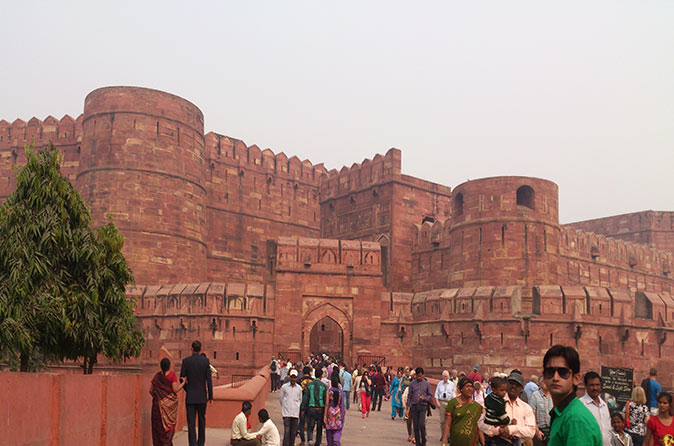
Itimad Ud Daulah
The first example of a tomb built on a riverbank in India, the Itimad Ud Daulah tomb houses the body of Mirza Ghiyas Beg, the father Mughal Empress Noor Jahan who again was Emperor Jahangir’s wife. This beautiful tomb situated on the banks of the Yamuna is also known as the ‘baby Taj’. Built around 1625 AD, the Itimad Ud Daulah Tomb, has many features that were later incorporated during the construction of the Taj Mahal. Interestingly, the carvings on this monument are said to be even better than that of the Taj.
Another distinguishable feature of this tomb is that it has been built in the Central Asian pattern of a domed structure complete with a formal garden, waterways and paths laid out in a geometrical pattern. The Itimad Ud Daulah’s tomb, built in pure marble is also the first Mughal structure to make extensive use of the Pietra Dura style of inlay work. One of the most beautiful tourist attractions in Agra, the Itimad Ud Daulah would really be an interesting experience for tourists.
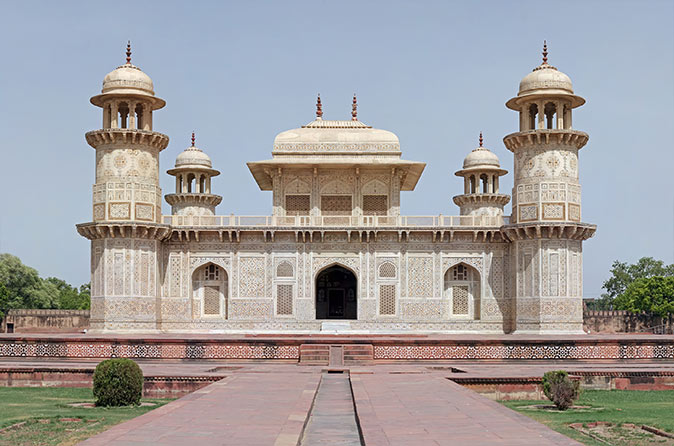
Akbar’s tomb
The Mughal Emperor Akbar, known as Akbar the Great, ruled an empire that stretched across North India from 1556 to 1605. His reign is considered the pinnacle of Mughal rule in India.
Akbar’s tomb is located in the serene ambience of Sikandra 3 km away from Agra. Akbar began building it during his lifetime and his son, the Mughal Emperor Jahangir, completed it. Some of its design features are similar to the design of the Taj Mahal built later in Agra. Akbar’s tomb at Sikandra has a large arched entrance and green lawns, on which deer can be seen grazing, surround the tomb.
The entrance is decorated with marble inlay work around the arch, and the inner surface of the dome of the tomb is decorated with images of flowers, geometric designs and Islamic calligraphy.
